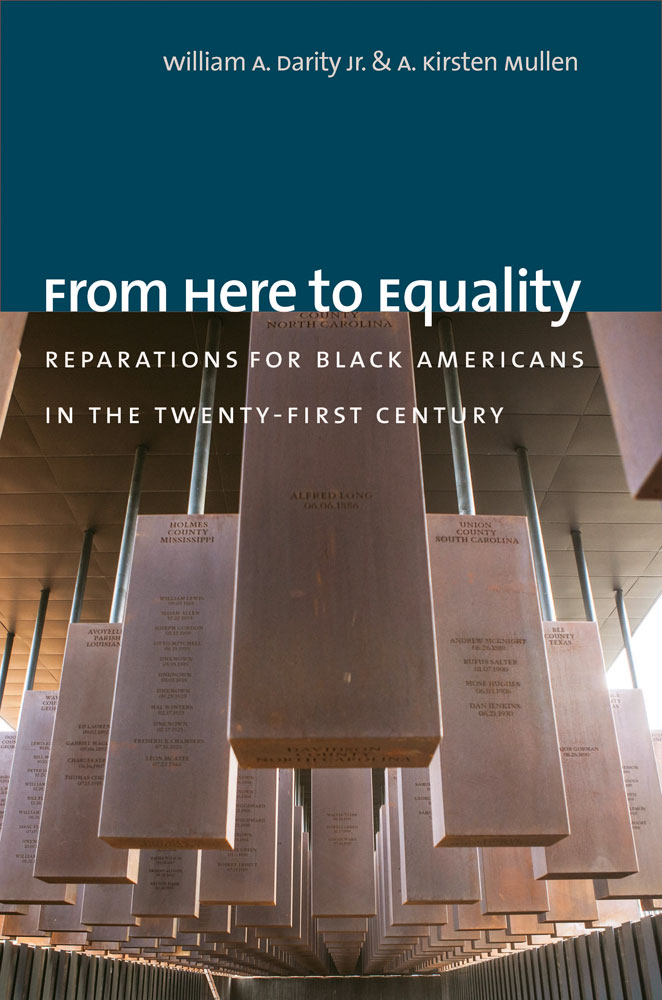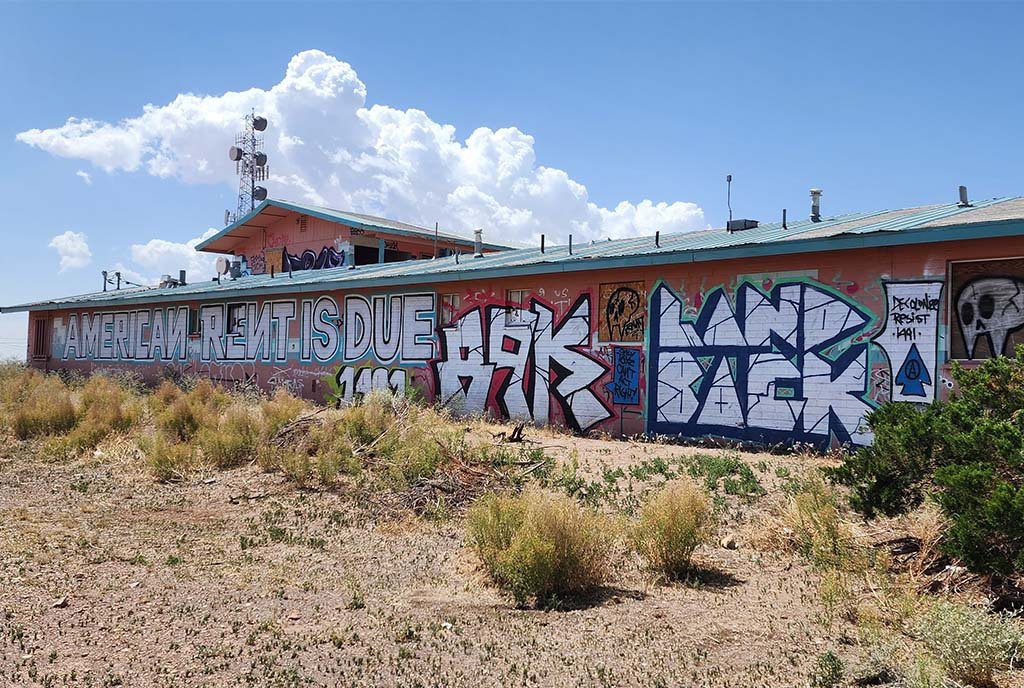
Reparations is increasingly a topic of political discussion, but what would reparations in the US, if approved, look like? Here, we present one plan that outlines a detailed program of reparations for black Americans. This passage is excerpted from portions of Chapter 13 of From Here to Equality: Reparations for Black Americans, authored by William A. (Sandy) Darity and A. Kirsten Mullen and published this spring by University of North Carolina Press. Excerpt reprinted with permission.
[Here] we present the “something that is often missing from ‘reparations talk’”: a detailed program of reparations for black Americans. We begin by calling upon the U.S. Congress to assert leadership and authorize payments to be made by the US government. Many atrocities, indignities, and micro- and macroaggressions have occurred in the well of American racism.
[…]
Specifically, the invoice should go directly to the US Congress, the legislative branch of the national government.
[…]
Given its traditional connection to these issues, the legislative branch can lay the groundwork for the design of a reparations program, first by establishing a commission that can investigate the history of racial injustice in the United States. This would be a commission similar to the one Congress created to investigate the circumstances of the mass incarceration of Japanese Americans during World War II, the Commission on Wartime Relocation and Internment of Civilians.3
[…]
We advance two criteria to determine eligibility for a black reparations program. First, US citizens would need to establish that they had at least one ancestor who was enslaved in the United States after the formation of the republic. Second, they would have to prove that they self-identified as “black,” “Negro,” “Afro-American,” or “African American” at least twelve years before the enactment of the reparations program or the establishment of a congressional or presidential commission “to study and develop reparations for African Americans”—whichever comes first. The first criterion, of course, could produce lucrative opportunities for private genealogists, but these investigations also could be facilitated by an arm of the professional (civil service) staff specializing in genealogical research for the agency that administers the reparations program.
[…]
With respect to the second criterion, any official government-issued document that indicates the individual’s race would provide acceptable proof of racial identity. Everyone also has the right to make public their responses to any U.S. Census question; specifically, one’s self-identification as black in response to the race question—before the existence of a reparations commission or reparations program makes it advantageous to do so—also would establish eligibility.
How much should be paid for black reparations? What is the size of the bill? It is customary, in the American court system, to assign monetary values for damages to human lives.
[…]
There are many effective options for financing a program of black reparations, even a program that would require a combined expenditure as large as $15 to $20 trillion. Obviously, lesser amounts would be managed more readily. For instance, even the full payout in 2016 based on our preferred standard—the racial gap in per capita wealth—would have amounted to less than half of [one year’s] total national income.
[…]
Two additional mechanisms for funding reparations merit consideration. First, historians V.P. Franklin and Mary Frances Berry have called for a “reparations superfund” that would pool government funding with contributions made by institutions and organizations that benefited from slavery, Jim Crow, and the continued subordination of black Americans.33
[…]
The superfund strategy would meld public and private responsibility for American racial injustice in funding a program of black reparations. However, we view public responsibility as paramount, since the federal government established and maintained the legal structure and pattern of enforcement that enabled private actors to engage in racist practices with impunity.
Second, as journalist Matthew Yglesias has proposed, Congress could direct the Federal Reserve to fund black reparations either in part or in total.35 Given the overnight transfer of $1 trillion of funds from the Federal Reserve to investment banks during the Great Recession and monthly outlays of $45 to $55 billion to conduct “quantitative easing,” there can be no doubt that the Fed has vast capacity to provide the funds required for a properly designed and financed reparations program, particularly if the funds are disbursed over the course of three to five years. The Fed certainly could manage an annual outlay of $1 to $1.5 trillion without any difficulty—and this funding mechanism would not have to affect tax rates for any American. Moreover, the Federal Reserve is a public bank charged with conducting a public responsibility.
[…]
Sign up for our free newsletters
Subscribe to NPQ's newsletters to have our top stories delivered directly to your inbox.
By signing up, you agree to our privacy policy and terms of use, and to receive messages from NPQ and our partners.
In addition to staggering the disbursements from the total commitment, trust funds and endowments could be set up on behalf of those eligible for the program that could not be used until a later date, particularly for younger recipients. Another related option would be to give recipients full discretion in the use of the annual interest on their trust accounts but require trustee judgment on any use they might propose for asset building and/or well-being enhancement by utilizing the principal. So, for example, if in the process of closing the racial wealth gap, each eligible recipient was given a trust account of $250,000, normal interest earnings would generate an average annual discretionary fund of approximately $12,000 given a stable level of the principal.
A twelve-member reparations supervisory board will be established, elected by all those with established eligibility for the reparations program, with its own paid professional staff. The supervisors will select the team to serve as trust account managers (or trustees), who will determine which proposed projects justify use of the principal on an account.
[…]
In addition to the functions performed by the board, a National Reparations Bureau (NRB) will be established as the civil service agency responsible for day-to-day management and execution of the program.38 The NRB will work closely with the General Accounting Office to ensure the financial fidelity of the black reparations program. The reparations agency’s staff will provide recipients, on an ongoing basis, with information about scams and fraudulent schemes directed against them as well as other matters relevant to successful personal management of their resources.39
The agency also will develop a financial management curriculum to be made available to all students and adults via public schools and other voluntary organizations, like communities of faith, starting before the inauguration of the reparations program. This will ensure that all recipients can receive pre-reparations preparation for managing their new portfolios.
[…]
Further, the NRB will be charged with implementing a concerted education effort to document, preserve, and communicate America’s history of racial injustice—the conditions that led to the adoption of a reparations program—and the impact of the reparations program on African American well-being and the nation as a whole.
The intensive phase of the public education effort should last for a minimum of three generations, or ninety years.
[…]
With the support of the NRB, the National Museum of African American History and Culture, the National Register of Historic Places, state historic sites, plantations and Civil War battle sites all can contribute to a transformative national process of reinterpretation and learning.
[…]
The work of national memory and national consciousness is an essential component of an effective program of black reparations.
Notes
3. John Tateishi, a Japanese American Citizens League activist who had been incarcerated at Manzanar, California, for three years, says of the wartime “internment”: “You can make this mistake, but you have to correct it—and by correcting, hopefully not repeat it again.” Retribution payments to 82,219 eligible claimants totaled $1.6 billion. In addition, the enabling legislation for Japanese American reparations provided for the establishment of the Civil Liberties Public Education Fund, directed to inform the public about the incarceration of Japanese Americans. A total of $50 million was allocated in 1988 “to sponsor research and public education activities”; however, an antispending lobby put the education program on hold until 1994, when funding was reduced to $5 million. President Bill Clinton appointed an advisory board in 1996, and the Civil Liberties Public Education Fund initiated the program in 1997–8. In 1998, a curriculum conference was held in San Francisco, and the Smithsonian Institution hosted an exhibition, Days of Remembrance, to recollect Franklin Delano Roosevelt’s signing of Executive Order 9066, which authorized the incarceration. The Japanese American National Museum in Los Angeles is the repository for the Civil Liberties Public Education Fund grant program records. See Bilal Qureshi, “From Wrong to Right: A U.S. Apology for Japanese Internment,” Code Switch, National Public Radio, August 3, 2013; and Densho Encyclopedia, s.v. “Civil Liberties Public Education Fund,” by Sharon Yamato.
33. See V.P. Franklin, “Introduction—African Americans and the Movement for Reparations: From Slave Pensions to the Reparations Superfund,” Journal of African American History 97, no. 1–2 (Winter–Spring 2012): 1–12; and Mary Frances Berry, “We Need a ‘Reparations Superfund,’” New York Times, June 9, 2014.
35. Matthew Yglesias, “Slavery Reparations Are Workable and Affordable,” Vox, May 23, 2014.
38. The Office of Redress Administration carried out the mandate of the Civil Liberties Act of 1988 to provide reparations payments for Japanese Americans who were incarcerated by the federal government during World War II. The NRB would constitute a parallel agency responsible for fulfilling the mandate of enabling legislation for reparations for black Americans.
39. The agency can maintain and disseminate a “Swindler’s List.”

Adapted from FROM HERE TO EQUALITY: REPARATIONS FOR BLACK AMERICANS IN THE TWENTY-FIRST CENTURY by William A. Darity Jr. and A. Kirsten Mullen. Copyright © 2020 William A. Darity Jr. and A. Kirsten Mullen. Used by permission of the University of North Carolina Press.











